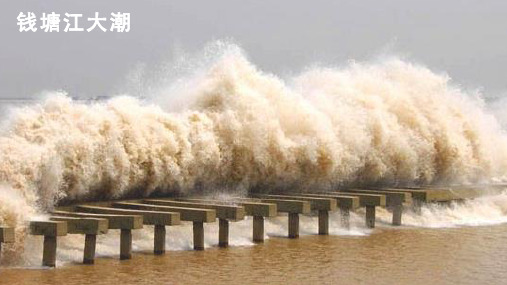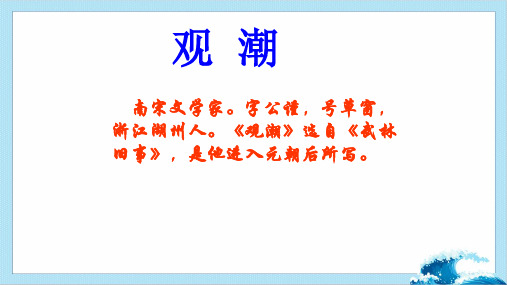观潮PPT教学课件
合集下载
1 观潮 课件(共29张PPT)

有关钱塘江大潮的诗句
天地黯惨忽异色,波涛万顷堆琉璃。 ——杜甫《美陂行》
海阔天空浪若雷,钱塘潮涌自天来。 ——王在晋《望江台》
一千里色中秋月,十万军声半夜潮。 ——李廓《忆钱塘》
桂林山水
四川九寨沟
吉林雾凇
课后作业
1、按一定顺序,写一个描写景物(或景观) 的片断。
2、如果你是小导游,你怎样向不了解钱塘 潮的游客介绍钱塘潮呢?
字词练习
一、多音字组词。
chēng( 称呼 )
bó ( 薄弱 )
称
薄
chèn ( 对称 )
báo ( 薄饼 )
二、比一比,再组词。 潮 ( 潮水 ) 堤 ( 堤岸 ) 嘲 ( 嘲笑 ) 提( 提醒 )
震 ( 地震 ) 振 ( 振奋 )
三、写出下列词语的近义词或反义词。 1.写近义词。
顿时——( 立刻 ) 屹立——( 矗立 )
2. 有感情地朗读课文,感受大自然的壮观, 受到自然美的熏陶。
3. 学习课文按照时间顺序描写景物的方法。
会认字
yán yì áng dùn 食盐 屹立 昂首 顿时
dǐng fèi guàn Leabharlann ào 人声 鼎 沸 横贯 浩浩荡荡
bēng zhèn shà yú 山崩地裂 震动 霎时 余波
会写字
潮据堤阔盼滚顿逐 渐堵犹崩震霎余
2.写反义词。
宽阔——( 狭窄 ) 平静——( 喧闹 ) 人声鼎沸 —— ( 鸦雀无声 )
整体感知
有感情地朗读课文,说一说课文的主要内容是什么?
本文记叙的是一次钱塘江观潮的盛况。作者 生动描绘了潮来前、潮来时、潮过后的景象,写 出了钱塘江大潮的奇特、雄伟、壮观,表达了作 者对大自然景色的赞美之情。
《观潮》课件(共36张PPT)

观潮
浙江之潮,天下之伟观也。自既望以至十八日/为盛。
指潮 发,起
景象 农历十六
是
方其/远出海门,仅如银线;既而渐近,则/玉城雪岭/际天 当……时 几乎,将近 不久 冲荡太阳连接着天
而来,大声/如雷霆,震撼激射,吞天沃日,势极雄豪。
像
用水淋洗
杨诚斋诗云“海涌银为郭,江横玉系腰”者/是也。
成为
这样的景象
观潮
• 〈1〉《观潮》第一句就说:“浙江之潮, 天下之伟观也”这一句话在文中有什么作 用?
• 揭示描写对象,总领全文,点明题旨。
• 〈2〉“伟观”具体表现在哪些方面?也就 是说作者是从哪些方面写观潮的?
• 第一段写海潮的雄伟壮观; • 第二段写水军演习的精彩场面; • 第三段写弄潮健儿的英姿; • 第四段写观潮人涌如潮。
而 际天而来
随波而逝 而,表修饰
溯迎而上
而旗尾略不沾湿
而僦赁看幕
而,表转折
吴儿善泅者数百,皆披发文身,手 持十幅大彩旗,争先鼓勇,溯迎而上, 出没于鲸波万仞中,腾身百变,而旗尾 略不沾湿,以此夸能。
几百个善于泅水的吴中健儿,披散着 头发,身上画着文彩,手里拿着十幅大彩 旗,争先奋力逆流迎潮而上, (他们的身 影)在万仞高的惊涛骇浪中浮沉,翻腾着 身子变换着各种姿态,而旗尾一点也不被 水沾湿,凭借这种(表演)来显示他们 (高超)的技能。
观潮人涌如潮:
写观潮人多马众与上文写钱塘江潮的气 势、 操练水军的情况及吴中健儿有何联系?
以观潮人多马众,侧面烘托钱塘江潮气 势的壮观,说明水军操练及吴中健儿的本领 高强,人人想一睹为快。
侧面描写与正面描写相结合,自然景观 与人文景观辉映成趣,更突出人在与自然搏 斗中的拼搏精神。
《观潮》(完美版)ppt

《观潮》(完美版 )ppt
• 潮起——背景与引言 • 潮涌——现象与原理 • 弄潮——活动与习俗 • 观潮之美——艺术与文学表现 • 科技之光——现代观测与预测技
术
目录
• 人与自然——生态保护与旅游开 发
• 总结回顾与拓展思考
目录
01
潮起——背景与引言
钱塘江大潮简介
钱塘江大潮的形成原因
天体引力和地球自转的离心作用,加 上杭州湾喇叭口的特殊地形所造成的 特大涌潮。
钱塘江大潮的特点
钱塘江大潮的地位
被誉为“天下第一潮”,是世界一大 自然奇观。
潮头壁立,波涛汹涌,犹如万马奔腾 ,蔚为壮观。
观潮历史与文化
观潮历史
自汉唐以来,钱塘江大潮就是东 南沿海的一大盛景,吸引了众多
游客前来观赏。
观潮文化
观潮不仅是一种自然景观的欣赏 ,更是一种文化的传承和发扬。 历代文人墨客留下了许多脍炙人 口的诗篇和画作,形成了独特的
05
科技之光——现代观测与预
测技术
潮汐观测技术发展历程
1 2
古代潮汐观测
依赖自然现象和简陋仪器,观测精度有限。
近代潮汐观测
随着科技进步,观测仪器逐渐精确,观测数据得 以积累和分析。
3
现代潮汐观测
采用先进技术和设备,实现自动化、实时化、高 精度观测。
现代科技在潮汐预测中应用
数值模型
基于物理定律和数学方法,构建潮汐数值模型,实现潮汐过程的 精确模拟和预测。
摄影作品
选取优秀摄影作品,展现观潮瞬间的壮丽景象和 摄影师的独特视角。
音乐舞蹈艺术呈现
古典音乐
引用古典音乐中与观潮相关的曲目,如《浪淘沙·观潮》等,通过音 乐旋律表现潮水的起伏和气势。
• 潮起——背景与引言 • 潮涌——现象与原理 • 弄潮——活动与习俗 • 观潮之美——艺术与文学表现 • 科技之光——现代观测与预测技
术
目录
• 人与自然——生态保护与旅游开 发
• 总结回顾与拓展思考
目录
01
潮起——背景与引言
钱塘江大潮简介
钱塘江大潮的形成原因
天体引力和地球自转的离心作用,加 上杭州湾喇叭口的特殊地形所造成的 特大涌潮。
钱塘江大潮的特点
钱塘江大潮的地位
被誉为“天下第一潮”,是世界一大 自然奇观。
潮头壁立,波涛汹涌,犹如万马奔腾 ,蔚为壮观。
观潮历史与文化
观潮历史
自汉唐以来,钱塘江大潮就是东 南沿海的一大盛景,吸引了众多
游客前来观赏。
观潮文化
观潮不仅是一种自然景观的欣赏 ,更是一种文化的传承和发扬。 历代文人墨客留下了许多脍炙人 口的诗篇和画作,形成了独特的
05
科技之光——现代观测与预
测技术
潮汐观测技术发展历程
1 2
古代潮汐观测
依赖自然现象和简陋仪器,观测精度有限。
近代潮汐观测
随着科技进步,观测仪器逐渐精确,观测数据得 以积累和分析。
3
现代潮汐观测
采用先进技术和设备,实现自动化、实时化、高 精度观测。
现代科技在潮汐预测中应用
数值模型
基于物理定律和数学方法,构建潮汐数值模型,实现潮汐过程的 精确模拟和预测。
摄影作品
选取优秀摄影作品,展现观潮瞬间的壮丽景象和 摄影师的独特视角。
音乐舞蹈艺术呈现
古典音乐
引用古典音乐中与观潮相关的曲目,如《浪淘沙·观潮》等,通过音 乐旋律表现潮水的起伏和气势。
观潮 课件(共26张PPT)

读课文,想想作者是按什么 顺序来写钱塘江大潮的?
课文按时间顺序来写大潮,按潮 来前、潮来时、潮过后的顺序把 钱塘潮的景象写具体的。
请你先按自然段阅读,弄清每个 自然段的意思。再按“潮来前”、 “潮来时”、“潮来后”、划分 段落层次。
潮来前
宽阔的钱塘江横卧在眼前。江面很平静,越往 东越宽,在雨后的阳光下,笼罩着一层蒙蒙的薄雾。 镇海古塔、中山亭和观潮台屹立在江边。远处,几 座小山在云雾中若隐若现。江潮还没有来,海塘大 堤上早已人山人海。大家昂首东望,等着,盼着。
从“隆隆的响声、闷雷滚动、山崩地裂、 颤动、风号浪吼”感受到江潮的声威。
从“宽阔、横卧、横贯江面、白浪翻滚、 奔腾西去、漫天卷地”体会到江潮的形状和 气势。
情感升华
请欣赏钱塘江大潮视频, 再次体导游,你应该 怎样向游客们介绍钱塘江潮呢?
•
yì
屹立
dǐng fèi
鼎沸
shà
霎时间
hào
áng
guàn
浩浩荡荡 昂首挺胸 全神贯注
yú
剩余
dùn
顿时
yán
食盐
近义词
屹立—— 耸立
昂首—— 抬头
笼罩—— 掩盖
反义词
宽阔—— 狭窄
顿时—— 立刻 风平浪静——波涛汹涌
人山人海—— 人烟稀少
chá o
本课字义:海水因 为受日、月的引力 而定时涨落的现象。
第一课 观潮
观潮
钱塘江与南美亚马逊河、南亚恒河 并称为“世界三大强涌潮河流”。独特的 地理环境和月球、太阳的引力作用使得钱 塘江潮成为世界著名涌潮之一。宋代词人 苏东坡称赞钱塘潮“八月十八潮,壮观天 下无”。
天下奇观 昂首东望 风平浪静 齐头并进
《观潮》ppt课件

第一段写海潮的雄伟壮观。
《观潮》第一句说:“浙江之潮,天下之伟观 也。”这句话在文中有什么作用? 点拨:用渲染的手法揭示了描写对象,点明了题旨, 揭示了中心,总领全文。
作者是从哪几个方面,按照什么顺序对潮来之 状进行描写的?
从形、色、声、势四个方面进行正面描绘, 由远及近刻画了海潮的雄伟壮观。
形:仅如银线 色:玉城雪岭 描写角度 声:声如雷霆
每岁京尹出浙江亭教阅水军,艨艟数百,分列两岸; 既而尽奔腾分合五阵之势,并有乘骑弄旗标枪舞刀于水面 者,如履平地。倏尔黄烟四起,人物略不相睹,水爆轰震, 声如崩山。烟消波静,则一舸无迹,仅有“敌船”为火所 焚,随波而逝。
吴儿善泅者数百,皆披发文身,手持十幅大彩旗,争 先鼓勇,溯迎而上,出没于鲸波万仞中,腾身百变,而旗 尾略不沾湿,以此夸能。
势:吞天沃日
把海潮从远方奔涌 到眼前的形状、颜 色、声势都生动地 表现了出来。
描写方法
比喻 渲染潮涌之状
夸张
引用:
概括上文,呼应首句,增强作者 这样写的逼真感和真实性。(进
一步描绘了海潮波澜壮阔的气势)
重点字词释义:
年
京都临安府长官
检阅
每岁京尹出浙江亭教阅水军,
战船
不久
穷尽
艨艟数百,分列两岸;既而尽奔
吴儿善泅qiú者﹨数百,皆﹨披发文身,手 持﹨十幅﹨大彩旗,争先鼓勇,溯sù迎而上, 出没mò于﹨鲸波万仞rèn中,腾身百变,而旗 尾﹨略不沾湿,以此夸能。
江干﹨上下﹨十余里间,珠翠罗绮qǐ ﹨溢目, 车马塞sè途,饮食百物﹨皆﹨倍穹qióng常时, 而﹨僦赁jiù lìn 看幕,虽﹨席地﹨不容间也。
重点字词释义:
江干上下十余里间,珠翠罗
满
堵塞
《观潮》第一句说:“浙江之潮,天下之伟观 也。”这句话在文中有什么作用? 点拨:用渲染的手法揭示了描写对象,点明了题旨, 揭示了中心,总领全文。
作者是从哪几个方面,按照什么顺序对潮来之 状进行描写的?
从形、色、声、势四个方面进行正面描绘, 由远及近刻画了海潮的雄伟壮观。
形:仅如银线 色:玉城雪岭 描写角度 声:声如雷霆
每岁京尹出浙江亭教阅水军,艨艟数百,分列两岸; 既而尽奔腾分合五阵之势,并有乘骑弄旗标枪舞刀于水面 者,如履平地。倏尔黄烟四起,人物略不相睹,水爆轰震, 声如崩山。烟消波静,则一舸无迹,仅有“敌船”为火所 焚,随波而逝。
吴儿善泅者数百,皆披发文身,手持十幅大彩旗,争 先鼓勇,溯迎而上,出没于鲸波万仞中,腾身百变,而旗 尾略不沾湿,以此夸能。
势:吞天沃日
把海潮从远方奔涌 到眼前的形状、颜 色、声势都生动地 表现了出来。
描写方法
比喻 渲染潮涌之状
夸张
引用:
概括上文,呼应首句,增强作者 这样写的逼真感和真实性。(进
一步描绘了海潮波澜壮阔的气势)
重点字词释义:
年
京都临安府长官
检阅
每岁京尹出浙江亭教阅水军,
战船
不久
穷尽
艨艟数百,分列两岸;既而尽奔
吴儿善泅qiú者﹨数百,皆﹨披发文身,手 持﹨十幅﹨大彩旗,争先鼓勇,溯sù迎而上, 出没mò于﹨鲸波万仞rèn中,腾身百变,而旗 尾﹨略不沾湿,以此夸能。
江干﹨上下﹨十余里间,珠翠罗绮qǐ ﹨溢目, 车马塞sè途,饮食百物﹨皆﹨倍穹qióng常时, 而﹨僦赁jiù lìn 看幕,虽﹨席地﹨不容间也。
重点字词释义:
江干上下十余里间,珠翠罗
满
堵塞
《观潮》-完整版PPT课件

日落江湖白,潮来天地清。
八月十八潮,壮观天下无。
潮来前 潮来时 潮退后
简介 潮来前 潮来时 潮过后 背诵 小结 练习 拓展
钱塘江大潮: 钱塘江大潮是出现在浙江省杭州
湾钱塘江口的涌潮,每年都吸引众多 中外游客来观看。
每逢农历8月18日,来浙江海宁一 带观潮的人,成群结队,络绎不绝。 我国的钱塘江大潮,世界著名。历来 被誉为“天下奇观”。
(再近些),只见白浪翻滚,形 成一道两丈多高的白色城墙。 (浪潮越来越近,)犹如千万匹白 色战马齐头并进,浩浩荡荡地飞 奔而来;那声音如同山崩地裂, 好像大地都被震得颤动起来。
吼涌可
。来是
, 江 面 上 依 旧 风 号 浪
余 波 还 在 漫 天 卷 地 地
霎 时 , 潮 头 奔 腾 去 ,
。江恢 水复 已了过 经平了 涨静好 了。久 两看, 丈看钱 来堤塘 高下江 了,才
观潮 闷雷滚动出白线 潮头怒吼贯江面 山崩地裂城墙现 钱塘奇观天下传
农历八月十八是一年一度的观 潮日。这一天早上,我们来到了海 宁县的盐官镇,据说这里是观潮最 好的地方。
宽阔的钱塘江横卧在眼前。江面 很平静,越往东越宽,在雨后的阳光 下,笼罩着一层蒙蒙的薄雾。
江潮还没有来,海塘大堤 上早已人山人海。大家昂首东 望,等着,盼着。
午后一点左右
过了一会儿……
一条白线
吞天沃日
游客朋友们,欢迎您来钱塘江观潮。你 听到了吗?远处传来隆隆的响声,好像闷雷 滚动,可江面还是风平浪静。你看,东边水 天相接的地方出现了一条白线了。那条白线 移动得很快,越来越粗,横贯江面。潮水已 经涌起两丈多高了,就像是一堵白色城墙。 潮水越来越近了,就像是千万匹白色战马飞 奔而来。你听,那声音快把人的耳朵都震聋 了。游客朋友们,你们认为钱塘江大潮是“ 天下奇观”吗?
八月十八潮,壮观天下无。
潮来前 潮来时 潮退后
简介 潮来前 潮来时 潮过后 背诵 小结 练习 拓展
钱塘江大潮: 钱塘江大潮是出现在浙江省杭州
湾钱塘江口的涌潮,每年都吸引众多 中外游客来观看。
每逢农历8月18日,来浙江海宁一 带观潮的人,成群结队,络绎不绝。 我国的钱塘江大潮,世界著名。历来 被誉为“天下奇观”。
(再近些),只见白浪翻滚,形 成一道两丈多高的白色城墙。 (浪潮越来越近,)犹如千万匹白 色战马齐头并进,浩浩荡荡地飞 奔而来;那声音如同山崩地裂, 好像大地都被震得颤动起来。
吼涌可
。来是
, 江 面 上 依 旧 风 号 浪
余 波 还 在 漫 天 卷 地 地
霎 时 , 潮 头 奔 腾 去 ,
。江恢 水复 已了过 经平了 涨静好 了。久 两看, 丈看钱 来堤塘 高下江 了,才
观潮 闷雷滚动出白线 潮头怒吼贯江面 山崩地裂城墙现 钱塘奇观天下传
农历八月十八是一年一度的观 潮日。这一天早上,我们来到了海 宁县的盐官镇,据说这里是观潮最 好的地方。
宽阔的钱塘江横卧在眼前。江面 很平静,越往东越宽,在雨后的阳光 下,笼罩着一层蒙蒙的薄雾。
江潮还没有来,海塘大堤 上早已人山人海。大家昂首东 望,等着,盼着。
午后一点左右
过了一会儿……
一条白线
吞天沃日
游客朋友们,欢迎您来钱塘江观潮。你 听到了吗?远处传来隆隆的响声,好像闷雷 滚动,可江面还是风平浪静。你看,东边水 天相接的地方出现了一条白线了。那条白线 移动得很快,越来越粗,横贯江面。潮水已 经涌起两丈多高了,就像是一堵白色城墙。 潮水越来越近了,就像是千万匹白色战马飞 奔而来。你听,那声音快把人的耳朵都震聋 了。游客朋友们,你们认为钱塘江大潮是“ 天下奇观”吗?
1《观潮》课件(共58张PPT).ppt

右下角有一撇,不 要丢掉。
结构:左中右 部首:氵
组词:热潮
cháo
dī
结构:左右 部首:土 组词:河堤
结构:上下 部首:龙 组词:笼络人心
lǒng
结构:上下 部首:罒 组词:罩住
zhào
结构:左右 部首:氵 组词:翻滚
gǔn
结构:左中右 部首:氵 组词:渐渐
jiàn
结构:上下 部首:山 组词:崩溃
巨浪叠加在水面上像千万匹战马齐头并进,大有荡涤一切之势。潮 头向着防波堤撞去,溅起冲天的浪花,霹雳之声,叫人不寒而栗。
此刻你的头脑中浮现出怎样的画面,选择印象最深的和同学交流。
参考答案:“快看,潮来了!”人们不约而同向他手指的方向望去, 只见在天水相接的地方,拱起了一条白线,浮在宽阔的海面上,向葫芦 把儿这边促来,越来越近,清晰地看见白线伸出的地方巨浪翻滚,伴着 闷雷般的轰鸣,大地仿佛也在颤抖。游客们屏息凝神,惊恐好奇的眼睛 注视着神使鬼差的奇景……
“过了好久,钱塘江才恢复了平静”,这句话表明了大潮退 去后,江面需要经过一段时间才能逐渐恢复到平静的状态。 这里的“过了好久”既是对时间的一种模糊描述,也体现了 江面恢复平静的不易。同时,它也暗示了钱塘江大潮对江面 影响之深、之广。
“看看堤下,江水已经涨了两丈来高了”,这句话则是对大 潮退去后江水水位变化的直接描述。两丈来高的水位涨幅, 不仅表明了大潮的汹涌澎湃和力量之大,也反映了钱塘江在 潮汐作用下的显著变化。这一变化不仅影响了江面的景观和 生态环境,也对沿岸的居民和设施产生了深远的影响。
潮来前: 江面—— 平静 人们心情—— 急切
农历八月十八是一年一度的观潮日。这一天早上,我 们来到了海宁县的盐官镇,据说这里是观潮最好的地方。
时间:农历八月十八,这是一个特别的日子,因为这一天 是钱塘江大潮最为壮观的时候,也是一年一度的观潮日。
结构:左中右 部首:氵
组词:热潮
cháo
dī
结构:左右 部首:土 组词:河堤
结构:上下 部首:龙 组词:笼络人心
lǒng
结构:上下 部首:罒 组词:罩住
zhào
结构:左右 部首:氵 组词:翻滚
gǔn
结构:左中右 部首:氵 组词:渐渐
jiàn
结构:上下 部首:山 组词:崩溃
巨浪叠加在水面上像千万匹战马齐头并进,大有荡涤一切之势。潮 头向着防波堤撞去,溅起冲天的浪花,霹雳之声,叫人不寒而栗。
此刻你的头脑中浮现出怎样的画面,选择印象最深的和同学交流。
参考答案:“快看,潮来了!”人们不约而同向他手指的方向望去, 只见在天水相接的地方,拱起了一条白线,浮在宽阔的海面上,向葫芦 把儿这边促来,越来越近,清晰地看见白线伸出的地方巨浪翻滚,伴着 闷雷般的轰鸣,大地仿佛也在颤抖。游客们屏息凝神,惊恐好奇的眼睛 注视着神使鬼差的奇景……
“过了好久,钱塘江才恢复了平静”,这句话表明了大潮退 去后,江面需要经过一段时间才能逐渐恢复到平静的状态。 这里的“过了好久”既是对时间的一种模糊描述,也体现了 江面恢复平静的不易。同时,它也暗示了钱塘江大潮对江面 影响之深、之广。
“看看堤下,江水已经涨了两丈来高了”,这句话则是对大 潮退去后江水水位变化的直接描述。两丈来高的水位涨幅, 不仅表明了大潮的汹涌澎湃和力量之大,也反映了钱塘江在 潮汐作用下的显著变化。这一变化不仅影响了江面的景观和 生态环境,也对沿岸的居民和设施产生了深远的影响。
潮来前: 江面—— 平静 人们心情—— 急切
农历八月十八是一年一度的观潮日。这一天早上,我 们来到了海宁县的盐官镇,据说这里是观潮最好的地方。
时间:农历八月十八,这是一个特别的日子,因为这一天 是钱塘江大潮最为壮观的时候,也是一年一度的观潮日。
《观潮》完整PPT课件

备、安全保障等方面的具体安排。
02
潮汐现象的观测与记录
指导学生在实践活动中观测和记录潮汐现象,如潮高、潮时等,培养学
生的实践能力和科学探究精神。
03
潮汐能源利用调研
组织学生调研潮汐能源利用的现状和前景,了解潮汐能源的原理、技术
、经济等方面的知识,培养学生的跨学科综合能力和社会责任感。
07
课堂互动与思考题
太阳引力作用
太阳引力也会对地球的潮汐产生 影响,但由于太阳距离地球较远
,其引力作用相对较弱。
地球自转
地球自转使得海水在月球和太阳 引力的作用下产生周期性的涨落
,形成潮汐现象。
钱塘江大潮特色及原因
大潮高度
钱塘江大潮潮差极大,最大潮差可达9米左右,为世界著名的大潮之一。
涌潮现象
钱塘江口呈喇叭形,潮水易进难退,当大量潮水从钱塘江口涌入时,由于江面迅速缩小, 使潮水来不及均匀上升,就只好后浪推前浪,层层相叠,形成涌潮。
观。
选择地点
选择合适的观赏地点也非常重要 ,一般来说,海宁县盐官镇东南 的一段海塘是最佳观赏地点。
注意天气
在观赏前要注意天气预报,选择 天气晴朗、风力较小的日子进行
观赏。
04
地域文化与民俗风情
钱塘江地区历史沿革
古代钱塘江流域的文明起源
01
介绍良渚文化等古代文明,阐述钱塘江地区悠久的历史渊源。
历代行政区划变迁
此句运用比喻和夸张的修辞手法,形象地描绘了潮水由远及近、奔腾而来的壮观景象,表现出大 自然的磅礴气势和无穷力量。
“杨诚斋诗云‘海涌银为郭,江横玉系腰’者是也”
引用杨万里的诗句,既是对前文描绘的补充和印证,也增加了文章的文学色彩和厚重感。
- 1、下载文档前请自行甄别文档内容的完整性,平台不提供额外的编辑、内容补充、找答案等附加服务。
- 2、"仅部分预览"的文档,不可在线预览部分如存在完整性等问题,可反馈申请退款(可完整预览的文档不适用该条件!)。
- 3、如文档侵犯您的权益,请联系客服反馈,我们会尽快为您处理(人工客服工作时间:9:00-18:30)。
用法10: 在-ing形式短语前可用
though/although表示让步 e.g. Though working very hard, he
couldn’t make enough money to pay off his debt. = Though he worked very hard, he couldn’t make enough money to pay off his debt.
用法1: 表示时间,多置于句首,也可置于句末 e.g. Walking in the street, I met a friend of mine. 用法2: 表示原因,多置于句首或句末,也可置于 句中 e.g. 1) Being ill, he didn’t go to school.
2) She rang him up, hoping to get his support.
28 观 潮
1.一词多义
自既望以至十八日为.盛动词,表判断,可译为“是” (1)为仅有“敌船”为.火所焚介词,表被动
海涌银为.郭动词,成为 势.极雄豪 名词,气势 (2)势既而尽奔腾分合五阵之势.名词,阵势 罔不因势.象形名词,形状 随波而.逝连词,表修饰,一般不译 (3)而腾身百变,而.旗尾略不沾湿连词,表转折,可 译为“但、却”等
2) Don’t laugh while eating.
3) Before going abroad, he lived here.
4) After watching TV, he went to bed.
用法8: 在-ing形式短语前可用介词on,表示“一…… 就……” e.g. On arriving in Beijing, he went to see his uncle.(= As soon as he arrived in Beijing, he went to see his uncle.) 用法9: 为了强调结果,可在-ing形式前加副词thus e.g. The bus was held up by the snowstorm, thus causing the delay.(= The bus was held up by the snowstorm, and as a result it caused the delay.)
= Though the old man was poor, he was happy.
用法5: 表示结果,常置于句末 e.g. The boy fell off his bike, breaking his right arm.
用法6: 表示方式或伴随,多置于句末,也可置于句首 e.g. 1) He sat at the table, reading a magazine.
2) Laughing and talking, they went into the room.
用法7: 为强调与谓语动词的动作同时发生,在-ing形式 短语前可用连词when, while等;为强调在谓语动 词的动作之前或之后发生,在-ing形式短语前可 用连词before或after
e.g. 1) Be careful when crossing the road.
5.助学背囊 (1)主题思想
本文描写了钱塘江潮的雄伟景象、水军演习的宏大场 面、吴中健儿高超的弄潮技巧以及观潮的盛况,表现了人与自 然搏斗的勇敢精神,也流露出作者身为南宋遗民的故国之思和 亡国之怨。
(2)文脉结构
观潮之海状潮潮 演 弄来 兵 潮之 之 之状 形 势: : :雄 精 勇伟 彩 敢壮 动 矫观 人 健正面描写自 人 风然 文 俗美 美 美 观潮之盛―→盛况空前―→侧面烘托
高二外研版选修六
Module2 Fantasy Literature
Grammar
动词的-ing形式作状语
动词的-ing形式作状语时,通常都表示 主语正在进行的另一动作,用来对谓语 动词表示的动作加以修饰或作为陪衬, 它可表示时间、原因、结果、条件、让 步、方式或伴随动作,相当于相对应的 状语从句。
immediately after another
1.Putting down his shopping bag , Will held out his hand. 2.Will, still watching, saw the cat behave curiously. 3. He crossed the road, keeping his eyes on the spot where the cat had been investigating. 4.Pushing his shopping bag through, he scrambled through himself.
(4)仅仅 仅. .如 有银“线 敌船副”词为,火几所乎焚,将连近词,仅仅 2.古今异义
(1)并有乘骑弄旗标.枪.舞刀于水面者 古义:_________举__枪___________________。 今义:田径运动使用的投掷器械。
(2)既而尽奔.腾.分合五阵之势 古义:__两__个__词__:__奔__,__疾__驶__;__腾__,__腾__起____。 今义:跳跃着奔跑。
3) The boy, being very polite, was loved by many teachers.
用法3: 表示条件,多置于句首 e.g. Working hard, you will succeed.
用法4: 表示让步,多置于句首 e.g. Being poor, the old man was happபைடு நூலகம்.
Grammar1–1. Choosing
Read the following sentences and make a choice.
__2___3_ describe two things happening at the
same time
_1____4_ describe one thing happening
3.词类活用 (1)乘骑. 弄旗标枪舞刀于水面者(动词用作名词,指马)
(2)饮食百物皆倍穹. 常时(形容词活用为动词,高过)
4.文言句式 (1)判断句 浙江之潮,天下之伟观也(“……也”表判断) (2)被动句 仅有“敌船”为火所焚(“为……所”表被动) (3)倒装句 ①出没于鲸波万仞中(介词结构“于鲸波万仞中”后置) ②并有乘骑弄旗标枪舞刀于水面者(介词结构“于水面” 后置)
